Dominique Luchart's Blog, page 652
April 14, 2021
Astronomers detect a bright-blue bridge of stars, and it’s about to blow, ,
Astrophysicists have found a new region of the Milky Way, and it’s filled with searingly hot, bright-blue stars that are about to explode.
The researchers were creating the most detailed map yet of the star-flecked spiral arms of our galactic neighborhood with the European Space Agency’s (ESA) Gaia telescope when they discovered the region, which they have named the Cepheus spur, they reported in a new study.
Nestled between the Orion Arm — where our solar system is– and the constellation Perseus, the spur is a belt between two spiral arms filled with enormous stars three times the mass of the sun and colored blue by their blistering heat.
Astronomers call these giant, blue stars OB stars due to the predominantly blue wavelengths of light that they emit. Stars of this type are the rarest, hottest, shortest-living and largest stars in the entire galaxy. The violent nuclear reactions taking place inside their hearts make them six times hotter than the sun. And the enormous stellar explosions that end their lives — called supernovas — scatter the heavy elements essential for complex life far into the galaxy.
Related: 11 fascinating facts about our Milky Way galaxy
“OB stars are rare, in a Galaxy of 400 billion stars there might be less than 200,000,” study co-author Michelangelo Pantaleoni Gonzalez, a researcher at the Spanish Astrobiology Center (CAB), told Live Science. “And as they’re responsible for the creation of a lot of the heavy elements, they can really be seen as the chemical enrichers of the galaxy. It’s because of stars like these, dead long ago, that the geochemistry of our planet was complex enough for biochemistry to arise.” Wherever we find blue stars, we find the most active and most “alive” regions of the galaxy, according to the researchers.
The researchers compiled their star map by triangulating the stars’ distances to Earth using a technique called stellar parallax. By comparing the apparent positions of the stars, observed from different perspectives during Earth’s orbit around the sun, astronomers can calculate the distances to the stars themselves. Using this technique, along with data from the ESA’s Gaia telescope, the team mapped out stars at distances beyond any of those charted before and in areas of space previously thought to be empty.
“After months of work, we saw this beautiful map for the first time,” Pantaleoni Gonzalez said. “I felt like an explorer of the enlightenment, tracing the first accurate maps of our world — just now on another scale. I felt extremely humble and tiny seeing how vast our stellar neighborhood is.”
The scientists proved that the new region was a part of the spiral galactic disk comprising most of our galaxy’s material, and not just a random alignment of stars, by observing them moving consistently in the same direction.
Related content
— From Big Bang to present: Snapshots of our universe through time
— 11 fascinating facts about the Milky Way
— The 15 weirdest galaxies in the universe
They also suspect that looking at the spur’s position, which is slightly above the galactic disk, could provide some tantalizing hints about the Milky Way’s past.
“If we are living in a galaxy with corrugations, which are slight vertical variations or ripples across its disk, it could point to a history of violent evolution for our galaxy,” Pantaleoni Gonzalez said. “They could be signs of past collisions with other galaxies.”
The next step for the researchers will be to put additional OB stars into a more precise map, which they hope will produce even more insights into our Galaxy’s structures.
The researchers published their findings March 19 in the journal Monthly Notices of the Royal Astronomical Society.
Originally published on Live Science.
The post Astronomers detect a bright-blue bridge of stars, and it’s about to blow, , appeared first on NEWDAWN Blog.
Rode Connect lets you mix up to four USB mics at once,
USB microphones are great for creators starting out in podcasting — until they have to mic more than one person in a room. There hasn’t been an efficient way to simultaneously record multiple USB mics on one computer, so now Rode is introducing an app that starts to offer a solution.
Rode’s new app, Rode Connect, lets you record multitrack or mixed stereo audio when plugging up to four USB microphones into your computer. There’s one big catch, though: for now, you can only do this with one model of USB microphone — Rode’s $99 NT-USB Mini.
You can think of the app as a virtual version of Rode’s $599 hardware mixer, the Rodecaster Pro, which allows you to plug in multiple XLR microphones, play audio clips, and record locally. The Rode Connect does that in an app on your computer with USB mics, which can come in handy for those who do not have an external mixer or professional microphones. But since the app is locked into Rode’s USB microphone ecosystem, it’s hard to take full advantage of it. The NT-USB Mini is also not necessarily the best-sounding USB microphone that even Rode has to offer, so you are pretty limited on sound quality as well.
Rode says the NT-USB Mini’s digital signal processing is the reason it’s the only microphone to work with this system. The processing lightens the load on the computer by having internal EQ and compression presets work inside the microphone instead of running through your computer.
According to Rode, there may be more models of its microphones added to the Rode Connect capability list. The company says, “We are actively looking at how we can expand the selection of microphones available for use with Rode Connect, and where possible we will integrate other Rode mics into the solution.”
Like the Rodecaster Pro, live-streaming seems to be an ideal use case for the new app. Rode Connect allows you to also add system audio to the mixer — which lets you mix in any sounds playing from your computer or a single application like FaceTime, Skype, Zoom, YouTube, and so on. If you have a streaming setup in something like OBS, you can select the aggregate sound device that Rode creates as your audio input, and the complete mix from Connect can be used in your stream, without having to play with the finicky OBS audio mixer controls or adding more CPU-intensive plugins. Having a separate audio-focused mixer program for more granular settings can significantly increase the production value on a live stream. This also opens up the possibility of mixing audio virtually into your Zoom call or perhaps some new social audio app.
Rode Connect seems to be an efficient way to use software to solve the problem with recording a bunch of USB mics with one device, but the product looks more like a way to convince consumers to buy multiples of Rode’s new microphones for the time being. As an audio engineer, I wouldn’t normally recommend someone buy four USB microphones for their roundtable podcast. If you bought four of these, it would cost $400. And at that price tag, you might as well buy a separate multichannel recording interface and plug in a couple of Shure SM58s. Then you can free up a couple of ports on your computer. As a reminder, the 2020 MacBook Air only has two ports.
The post Rode Connect lets you mix up to four USB mics at once, appeared first on NEWDAWN Blog.
Urbanista is the latest company to take a swing at solar-powered headphones,
Urbanista’s new wireless noise-canceling Los Angeles headphones have a solar panel integrated into the length of the headband, allowing them to draw power from both indoor and outdoor light, Wired reports. Although its built-in 750mAh battery can be charged traditionally via USB-C and offers up to a respectable 50 hours of battery life, the real appeal to these headphones is the solar charging. They’re due to ship in early summer for GBP169 (around $232), according to Wired.
Although Urbanista’s site promises “infinite playtime” from the headphones, the exact amount of power these headphones can generate while solar charging varies. One hour spent in the sun should generate enough power for three hours of playtime, but on a cloudy day that drops to just two hours, the company says. In a worst case scenario on a long-distance plane flight, Wired notes you’d need around eight hours of light exposure to get an hour of listening.
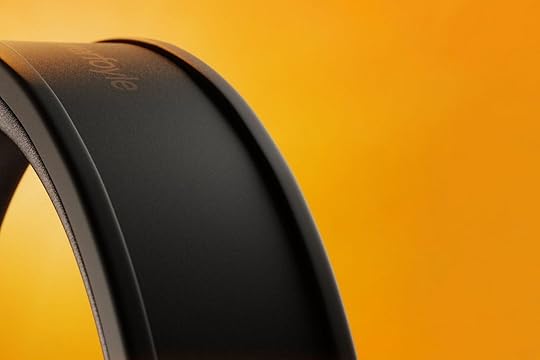 The solar panel is built neatly into the headband.Image: Urbanista
The solar panel is built neatly into the headband.Image: UrbanistaBeyond their solar-powered smarts, the Urbanista’s Los Angeles headphones are similar to its existing Miami range. They’ve got built-in microphones for use with voice assistants like Siri or Google Assistant, on-ear detection, an ambient sound mode, and they wirelessly connect over Bluetooth 5.0. In the box you get a carrying case, audio cable, and in-flight adaptor.
JBL announced a very similar pair of solar-powered headphones back in December 2019, which was subsequently crowdfunded on IndieGoGo. However, the Reflect Eternal headphones aren’t yet available. In December 2020 the company posted an update on the project’s page saying the headphones were facing “major delays” due to the pandemic, and that it would be offering refunds to its backers.
Both JBL’s and Urbanista’s headphones rely on the same Powerfoyle solar charging technology developed by a company called Exeger. “JBL were a bit unlucky with Covid hitting, and so Urbanista became lucky because we’re in the same city,” Exeger’s CEO Giovanni Fili told Wired. “We’re looking forward to picking it up with JBL as soon as they can.”
The post Urbanista is the latest company to take a swing at solar-powered headphones, appeared first on NEWDAWN Blog.
Sale doc: Indonesian e-commerce company Bukalapak raises $234M round led by Microsoft, Singapore sovereign wealth fund GIC, and local media conglomerate Emtek (Anshuman Daga/Reuters)
The post Sale doc: Indonesian e-commerce company Bukalapak raises $234M round led by Microsoft, Singapore sovereign wealth fund GIC, and local media conglomerate Emtek (Anshuman Daga/Reuters) appeared first on NEWDAWN Blog.
April 13, 2021
On This Day in Space! April 13, 1969: NASA launches Nimbus 3 weather satellite, ,
On April 13, 1969, NASA launched a new weather satellite called Nimbus 3. This was the third in a series of second-generation research and development satellites NASA launched to test new technologies for weather forecasting.
Nimbus 3 had an infrared spectrometer that allowed it to record temperatures throughout the Earth’s atmosphere. It could also detect electromagnetic radiation in a whole spectrum of wavelengths, which helps scientists determine the structure of the atmosphere.
The satellite also had cameras that provided real-time images of cloud coverage. Nimbus 3 launched on a Thor-Agena rocket from Vandenberg Air Force Station in California and entered a polar orbit.
Two months later, one of its instruments failed. After more of them broke down, NASA terminated the mission in 1972.
Catch up on our entire “On This Day In Space” series on YouTube with this playlist.
[image error]
History of NASA: $22.99 at Magazines Direct
Discover the story of how and why NASA was created, its greatest triumphs, darkest days, and of the times it exceeded all possible hopes. A tale of adventure, heroism and resourcefulness, learn of the space agency’s greatest achievements and how — over six decades — the organization has consistently and tirelessly devoted itself to its founding principle: that “activities in space should be devoted to peaceful purposes for the benefit of all humankind”. View Deal
Still not enough space? Don’t forget to check out our Space Image of the Day, and on the weekends our Best Space Photos and Top Space News Stories of the week.
Email Hanneke Weitering at hweitering@space.com or follow her @hannekescience. Follow us @Spacedotcom and on Facebook.
Join our Space Forums to keep talking space on the latest missions, night sky and more! And if you have a news tip, correction or comment, let us know at: community@space.com.
The post On This Day in Space! April 13, 1969: NASA launches Nimbus 3 weather satellite, , appeared first on NEWDAWN Blog.
‘Dark sirens’ could solve one of the greatest mysteries in cosmology, ,
In recent years, cosmologists have been faced with a crisis: The universe is expanding, but no one can agree on how fast it’s moving away from us.
That’s because different ways of measuring the Hubble constant, a fundamental parameter that describes this expansion, have produced conflicting results.
But a single, lucky observation of what are known as dark sirens — black holes or neutron stars whose crashes can be picked up by gravitational wave detectors on Earth but remain invisible to ordinary telescopes — could help resolve this tension.
As the cosmos expands, galaxies in the universe move away from Earth at a speed that depends on their distance from us. The relationship between speed and distance is called the Hubble constant, after American astronomer Edwin Hubble, who first calculated its value in the 1920s.
Related: 8 ways you can see Einstein’s theory of relativity in real life
By looking at flickering stars known as Cepheids in the local universe, some researchers have produced modern, highly precise measurements of the Hubble constant. But a rival method relying on a relic of light from 380,000 years after the Big Bang, known as the cosmic microwave background (CMB), yields a completely different answer, leaving cosmologists scratching their heads about what’s going on.
“Gravitational waves can give you a different handle on the Hubble constant,” Ssohrab Borhanian, a physicist at Pennsylvania State University, told Live Science.
When massive objects such as black holes or neutron stars smash together, they warp the fabric of space-time, sending out gravitational waves. Since 2015, the U.S. Laser Interferometer Gravitational-Wave Observatory (LIGO) and its European counterpart Virgo have been listening for such massive crashes, which ring in their detectors like little bells.
Depending on their distance from Earth, these events will sound louder or quieter to LIGO, enabling scientists to calculate how far away they happened. In some cases, the clatter of these heavy entities also results in a flash of light that astronomers may catch in their telescopes, encoding information about how fast they are traveling away from us.
So far, researchers have only observed one such event with both gravitational wave and light signals, a pair of neutron stars that astronomers observed in 2017 in both LIGO’s detectors as well as other telescopes. From this, physicists have calculated a value for the Hubble constant, though the error bars on the measurement are large enough to overlap with both the results coming from flickering stars and those from the CMB, Borhanian said.
Prior work showed that cosmologists would need to see about 50 events like this, which are fairly rare, in order to get a more precise Hubble constant calculation, he added.
Dark sirens offer a potentially quicker route. Such crashes are not associated with flashes of light, which contain the all-important information on speed. These events, which are invisible except through gravitational waves, are the most common signals picked up at LIGO and other gravitational wave facilities.
Over the next five years, LIGO’s detectors are expected to receive upgrades that will enable them to unpack many more details of gravitational wave signals and pick up far more events, including more dark sirens. The U.S. and European facilities have recently been joined by the Kamioka Gravitational Wave Detector (KAGRA) in Japan, and an Indian detector should come online around 2024.
One day, the network should be able to pinpoint where in the sky a dark siren crash happened 400 times better than scientists currently can, Borhanian said. With this information, astronomers can identify a galaxy in the exact location where the smash took place, and then determine how quickly that galaxy is speeding away from Earth. There will be no need to also find an associated flash of light.
Borhanian and his team have shown that crashes between objects that are particularly loud, heavy, or unequal in mass, which they call golden dark sirens, will be particularly information-rich, producing data that might pin down a gravitational wave crash so well they can calculate the Hubble constant with high precision.
“We can do this with a single event, instead of 50,” he said, and it will perhaps be enough to sway the cosmology community towards one measurement or the other. Borhanian will present his group’s findings at the American Physical Society‘s April meeting on April 18.
Related content
— From Big Bang to present: Snapshots of our universe through time
— The biggest unsolved mysteries in physics
Because dark sirens can potentially provide such excellent distance measurements from pure physics alone, they are “extremely unique, and extremely clean and appealing,” said Maya Fishbach, a gravitational wave astronomer and LIGO team member at Northwestern University in Evanston, Illinois, who was not associated with the work.
The group’s results suggest that LIGO and its counterparts around the world should start seeing many more well-localized events in the near future, she said. But it’s possible that other measurements may resolve the crisis over the Hubble constant before dark sirens will, Fishbach told Live Science.
Still, Fishbach is excited about the potential for the field of gravitational wave cosmology to answer other fundamental questions in the future, such as the nature and details of dark energy, the mysterious substance driving an accelerated expansion of the universe.
Editor’s Note: This story was updated on Friday, April 9 at 1:40 p.m. E.T. to note that dark sirens could pinpoint the location of gravitational wave sources 400 times, not 40,000 times, better than scientists currently can.
Originally published on Live Science.
The post ‘Dark sirens’ could solve one of the greatest mysteries in cosmology, , appeared first on NEWDAWN Blog.
NASA’s Mars helicopter Ingenuity won’t fly until next week at the earliest, ,
We’ll have to wait a bit longer to see the first Mars helicopter lift off.
NASA had originally aimed to conduct the first Red Planet flight of its Ingenuity helicopter — the first-ever powered flight on a world beyond Earth — on Sunday (April 11). A high-speed rotor-spinning test on Friday (April 9) didn’t go as planned, however, pushing the debut back until Wednesday (April 14) at the earliest.
Now, after analyzing the issue over the weekend, the Ingenuity team has concluded “that minor modification and reinstallation of Ingenuity’s flight control software is the most robust path forward,” officials at NASA’s Jet Propulsion Laboratory (JPL) in Southern California, which manages Ingenuity’s technology-demonstrating mission, wrote in an update Monday (April 12).
“Our best estimate of a targeted flight date is fluid right now, but we are working toward achieving these milestones and will set a flight date next week,” NASA officials wrote in the update.
Related: Watch NASA’s Mars helicopter Ingenuity test its blades! (video)
Validating the software change and beaming it to the 4-lb. (1.8 kilograms) chopper, via NASA’s Perseverance rover, will take some time, the officials added. A detailed timeline is still being worked out, and the team plans to set a new flight date next week.
“We are confident in the team’s ability to work through this challenge and prepare for Ingenuity’s historic first controlled, powered flight on another planet,” officials wrote. Ingenuity remains healthy and stable, and its vital systems such as power and communications are working properly, they added.
Perseverance and Ingenuity landed together inside Mars’ 28-mile-wide (45 kilometers) Jezero Crater on Feb. 18. On April 3, the solar-powered helicopter deployed from the rover’s belly and began soaking up the Martian sun for the first time.
After powering up, Ingenuity began going through a series of preflight checkouts. The chopper sailed through all of these tests except the final one — Friday’s spinup, which aimed to get Ingenuity’s two rotors up to 2,400 revolutions per minute, the same rotational speed they’ll reach during flight.
But during the test, “the command sequence controlling the test ended early due to a ‘watchdog’ timer expiration,” NASA officials wrote in a statement on Saturday (April 10). “This occurred as it was trying to transition the flight computer from ‘Pre-Flight’ to ‘Flight’ mode.”
Ingenuity carries two cameras but no scientific instruments. Its main task is to show that powered flight on Mars is possible, potentially opening up a new mode of exploration on the Red Planet. If Ingenuity’s month-long flight campaign is successful, future Mars missions could commonly include helicopters as scouts for rovers or as data gatherers in their own right, NASA officials have said.
Perseverance is supporting Ingenuity’s test campaign — the mission team must route communications to and from the helicopter through the rover — and will attempt to capture high-resolution imagery of its flights as well.
While the helicopter team works out Ingenuity’s issues, JPL officials said, Perseverance will continue studying nearby rock targets and prepare for a test of another technology demonstration — the Mars Oxygen In Situ Resource Utilization Experiment (MOXIE), an instrument on the rover designed to generate oxygen from the carbon dioxide-dominated Martian atmosphere.
Once Ingenuity has finished its flights, Perseverance will focus fully on its own mission, which has two main goals: searching for evidence of ancient life on the floor of Jezero Crater, which hosted a lake and a river delta long ago, and collecting dozens of samples for future return to Earth.
Mike Wall is the author of “ Out There ” (Grand Central Publishing, 2018; illustrated by Karl Tate), a book about the search for alien life. Follow him on Twitter @michaeldwall. Follow us on Twitter @Spacedotcom or Facebook.
The post NASA’s Mars helicopter Ingenuity won’t fly until next week at the earliest, , appeared first on NEWDAWN Blog.
SpaceX’s SN15 Starship prototype rolls out to launch pad, ,
SpaceX is moving on quickly from its latest fallen Starship prototype.
Elon Musk’s company rolled out the newest Starship test vehicle, known as SN15 (“Serial No. 15”), its South Texas launch pad last Thursday (April 8), just over a week after its predecessor exploded during a high-altitude flight.
That previous vehicle, SN11, performed well during most of its 6.2-mile-high (10 kilometers) flight on March 30 but suffered a serious problem while gearing up for landing. (SpaceX skipped the SN12, SN13 and SN14 iterations, going directly from SN11 to SN15.)
Video: Watch SpaceX’s Starship SN11 launch on a test flight
That’s been the pattern for all four Starship prototypes that have attempted this leap in the past four months: All flew nicely until the very end but couldn’t stick the landing. (SN10 actually landed in one piece in early March, but it exploded a few minutes later.)
SpaceX is now grooming SN15 for a similar flight in the near future. There’s reason to be optimistic about a different outcome this time, and not just because SpaceX tends to learn quickly from issues that crop up during testing: SN15 is a much-improved Starship prototype, featuring “hundreds of design improvements across structures, avionics/software & engine,” Musk said via Twitter late last month.
SpaceX is developing Starship to take people and cargo to the moon, Mars and other faraway locations. The deep-space transportation system consists of two elements, both of which are designed to be fully reusable: a 165-foot-high (50 meters) spacecraft called Starship and a giant first-stage rocket known as Super Heavy.
Both Starship and Super Heavy will be powered by SpaceX’s next-generation Raptor engines — six for the spacecraft and about 30 for the first-stage booster. Like the four other vehicles that tried the 6-mile leap, the SN15 prototype sports three Raptors.
Mike Wall is the author of “ Out There ” (Grand Central Publishing, 2018; illustrated by Karl Tate), a book about the search for alien life. Follow him on Twitter @michaeldwall. Follow us on Twitter @Spacedotcom or Facebook.
Join our Space Forums to keep talking space on the latest missions, night sky and more! And if you have a news tip, correction or comment, let us know at: community@space.com.
The post SpaceX’s SN15 Starship prototype rolls out to launch pad, , appeared first on NEWDAWN Blog.
Blue Origin to launch ‘astronaut rehearsal’ New Shepard test flight Wednesday. How to watch live., ,
Blue Origin plans to launch an uncrewed test flight of its New Shepard suborbital vehicle on Wednesday (April 14), and you can watch the action live online.
The company, which is led by Amazon.com founder Jeff Bezos, will launch New Shepard from its West Texas site on Wednesday during a window that opens at 9 a.m. EDT (1300 GMT; 8 a.m. local time), if all goes according to plan. You can watch it on this page and here, as well as on the Space.com homepage, starting an hour before liftoff, courtesy of Blue Origin, or directly via the company.
Blue Origin is developing New Shepard, a reusable rocket-capsule combo, to take paying customers and payloads on brief trips to suborbital space. Wednesday’s flight, known as NS-15, won’t carry any people, but it will be a substantial step toward crewed operations.
Related: Blue Origin’s NS-11 New Shepard test flight in photos
“During the mission, astronaut operational exercises will be conducted in preparation for human spaceflight,” Blue Origin representatives wrote in a mission description.
“The primary operations will entail Blue Origin personnel standing in as astronauts entering into the capsule prior to launch,” they added. “These astronauts will climb the launch tower, get into their seats, buckle their harnesses and conduct a communications check from their seat with CAPCOM, the Capsule Communicator.”
The Blue Origin personnel will depart the New Shepard capsule before launch. After landing, they’ll get back into the capsule to rehearse exit procedures, according to the description.
NS-15 will be the 15th New Shepard flight overall and the second for NS-4, the new and upgraded vehicle that’s expected to be the first to carry astronauts. Like NS-4’s initial flight, which occurred in January, Wednesday’s test mission will carry aloft Blue Origin’s instrument-laden dummy, Mannequin Skywalker, and thousands of postcards, the mission description states.
These postcards were sent in by students around the world via Blue Origin’s nonprofit organization, Club for the Future, which organized such operations on several previous New Shepard flights as well.
Mike Wall is the author of “ Out There ” (Grand Central Publishing, 2018; illustrated by Karl Tate), a book about the search for alien life. Follow him on Twitter @michaeldwall. Follow us on Twitter @Spacedotcom or Facebook.
Join our Space Forums to keep talking space on the latest missions, night sky and more! And if you have a news tip, correction or comment, let us know at: community@space.com.
The post Blue Origin to launch ‘astronaut rehearsal’ New Shepard test flight Wednesday. How to watch live., , appeared first on NEWDAWN Blog.
OnePlus Watch review: big, basic, and boring,
What makes a smartwatch “smart”? Is it the ability to show you notifications from your phone? What about the ability to track your physical activity and wellness, such as step counts, workouts, and sleep? How about providing you information about your day, such as the weather and upcoming calendar events? Or perhaps it’s the inclusion of a voice assistant on your wrist that you can ask to do things without having to use your phone?
Those are the questions I’ve been asking over the past week-plus as I’ve been testing the new OnePlus Watch, a $159 smartwatch and the first wearable from the smartphone company. The OnePlus Watch has all the looks of a modern smartwatch, but as I’ve learned wearing it on my wrist day and night, it doesn’t have all the smarts.
The OnePlus Watch is not like a Wear OS smartwatch, such as those made by Fossil, Motorola, or Mobvoi. Nor is it like a Samsung Galaxy Watch or an Apple Watch. All of those have software platforms that integrate with other apps and services, so you can download apps or watchfaces to the watch itself, just like you might with a phone. That makes them very extensible and customizable — you can easily make the watch look unique and do the things you need it to.
The OnePlus Watch, on the other hand (or wrist?), runs its own proprietary software, based on a real-time operating system. This software is very quick and power efficient, but it is not extensible — there’s no app store or third-party watchfaces to download on the OnePlus Watch. It’s similar to the software on the budget smartwatches you can get on Amazon; if you’ve ever used an Amazfit, Umidigi, or Wyze watch, you’ve used a real-time operating system. The OnePlus Watch is not very different from those in this respect.
This choice of platform affords the OnePlus Watch its greatest strength, long battery life, and also its greatest weakness: it just doesn’t do all that much compared to other smartwatches you can buy.
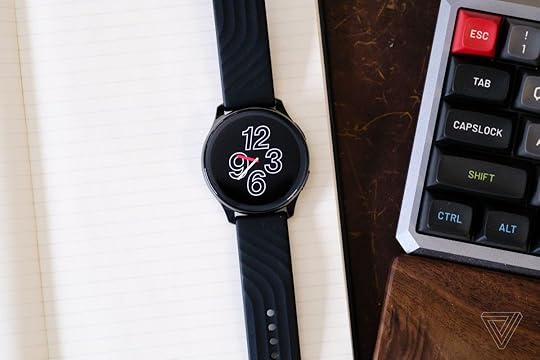 The OnePlus Watch looks like many other smartwatches, but most especially the Samsung Galaxy Watch Active.OnePlus Watch software
The OnePlus Watch looks like many other smartwatches, but most especially the Samsung Galaxy Watch Active.OnePlus Watch softwareThe OnePlus Watch pairs with and is controlled by the OnePlus Health app for Android — there’s no iPhone compatibility at all. But you don’t need to own a OnePlus phone, it works with basically any modern Android device. I tested it on both OnePlus and Samsung smartphones and the experience was the same.
The app is where you can see what health and fitness metrics the watch has recorded, adjust which apps send notifications on your wrist, and view the available watchfaces. OnePlus has about 50 watchfaces so far, with some offering limited customizability in the form of selectable shortcuts or widgets, such as a weather widget, date, or shortcut to a built-in app like the timer. You can choose up to 14 faces to store on the watch and switch between them without using your phone. The company says it plans on adding more in the future, but as I mentioned earlier, there are no options for third-party watchfaces or third-party app widgets like you get with Samsung, Wear OS, or Apple smartwatches.
The watchfaces themselves are what you’d expect: there is the assortment of analog and digital styles to choose from, with some showing more information about your activity than others. I’m not a big fan of the analog options, so I settled on a digital face. Unfortunately, there’s a bug where digital watchfaces on the OnePlus Watch are stuck in 24-hour time and can’t show 12-hour time. The company tells me it is aware of this bug, and it is slated to be fixed “this month.”
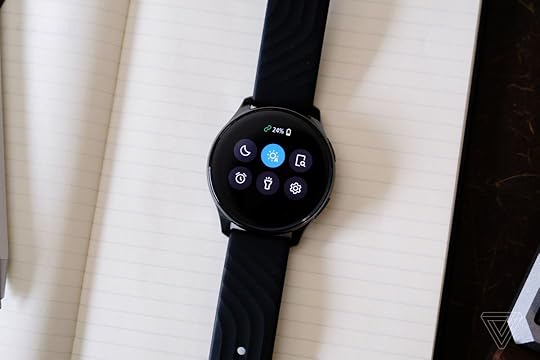 The OnePlus Watch’s interface mimics Wear OS and is easy to navigate.
The OnePlus Watch’s interface mimics Wear OS and is easy to navigate.The watch interface has a familiar layout: swipe down for settings, swipe up to see notifications, press the side button to see your apps. You can swipe right from the watchface to access basic widgets for music control, weather, and activity tracking, similar to Wear OS or a Samsung watch. The design of the interface all looks mostly fine, and there thankfully aren’t any stutters or lags when navigating it.
I do have a few gripes with how notifications are handled. You can’t clear notifications by just swiping them away, like you can with every other smartwatch. Instead, you have to tap into each one and then press clear or scroll to the bottom to clear them all. It’s a clumsy and fiddly process. The OnePlus Watch doesn’t always sync with the notifications I’ve cleared on my phone, either, and occasionally notifications for the same messages would get duplicated, forcing me to see the same alerts more than once.
You can’t do much with those notifications, either. There are no actions you can take other than clearing them from your wrist. OnePlus supports canned message replies in just five apps: WhatsApp, Telegram, Line, Discord, and Facebook Messenger. Notably and frustratingly, that list doesn’t include standard SMS messages. On top of that, there are only four basic replies to choose from: “OK”; “Be right there!”; “In a meeting, contact you later”; and “I’m driving, contact you later.” I frequently use a smartwatch to triage notifications, delete incoming emails, or reply to messages when I’m away from my desk, but I can’t do most of those things with the OnePlus Watch.
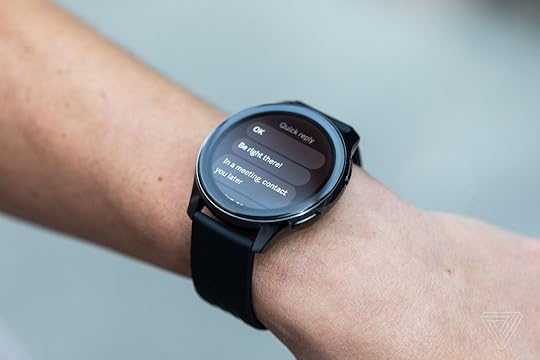 The OnePlus Watch supports quick replies in just five apps and there are only four replies to choose from — you cannot use your voice to dictate something to the watch.Photo by Vjeran Pavic / The Verge
The OnePlus Watch supports quick replies in just five apps and there are only four replies to choose from — you cannot use your voice to dictate something to the watch.Photo by Vjeran Pavic / The Verge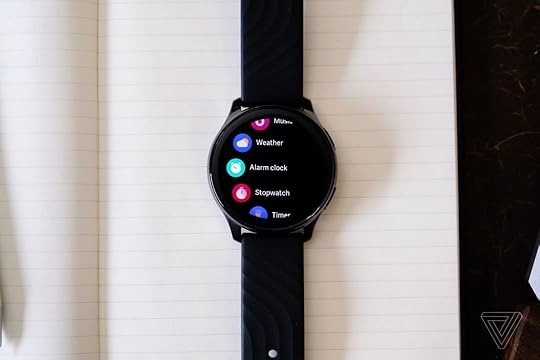 The OnePlus Watch does not support third-party apps, what you get is what you get.
The OnePlus Watch does not support third-party apps, what you get is what you get.The OnePlus Watch comes with a basic set of apps: weather, timer, stopwatch, alarm, workout, sleep tracking, etc. Oddly, it doesn’t have a calculator or a calendar app, so I can’t easily see my next meeting or appointment, something I do a lot with other smartwatches. There’s no way to get your next appointment on your watchface, either. And since there isn’t an app store, I can’t add any apps to that list.
You can forget about streaming music from Spotify or playing podcasts through your favorite app — the only thing you can do with the OnePlus Watch is control what’s playing on your phone or transfer MP3 files from your phone to the watch’s 4GB of storage. Want to track your runs with Strava or MapMyFitness instead of OnePlus’ app? Sorry, no dice. If you want to control smart home devices from your wrist, the OnePlus Watch is entirely useless unless you have a OnePlus TV, where you can use it as a remote. The OnePlus TV is only available in India.
The OnePlus Watch also lacks a voice assistant. I can’t ask it to start a timer when I’m in the kitchen and my hands are dirty, I can’t ask it to turn the lights off or open my garage door, and I can’t dictate a reply to an incoming message. How well voice assistants work varies greatly between smartwatches (Siri on the Apple Watch, pretty good! Bixby on a Samsung watch, less so), but OnePlus isn’t even trying here and I’ve missed having one available.
Lastly, even though the OnePlus Watch has an NFC radio, it does not support mobile payments. You can’t tap your wrist to pay for something like you can with an Apple Watch, Samsung watch, or Wear OS smartwatch.
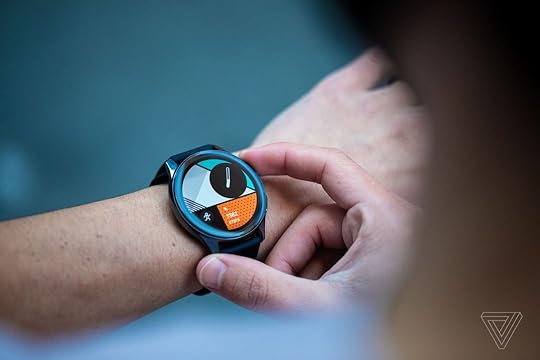 The OnePlus Watch’s fitness tracking features hit the standard beats.Photo by Vjeran Pavic / The VergeOnePlus Watch fitness tracking
The OnePlus Watch’s fitness tracking features hit the standard beats.Photo by Vjeran Pavic / The VergeOnePlus Watch fitness trackingThe fitness tracking features are quite basic. It will track your steps throughout the day; the watch will nudge you to get up and move when you’ve been sitting for too long; you can choose between 14 different workouts for the watch to track; and if you wear the OnePlus Watch to bed, it will make an attempt to track your sleep.
I’m not a gym rat, but I did wear the OnePlus Watch on my left wrist with a Fitbit Inspire HR on my right wrist throughout this review and the OnePlus counted thousands fewer steps than the Fitbit every day. None of these devices are perfect with their step tracking, but that kind of discrepancy is going to make tracking a longer-distance run or other intense workout inaccurate or just plain hard to do. I asked a few other reviewers I know who are also testing the OnePlus Watch and each one has had the same issues with inaccurate step counting. OnePlus says a bug fix for GPS optimization and to add more workout modes will be available sometime in mid-April.
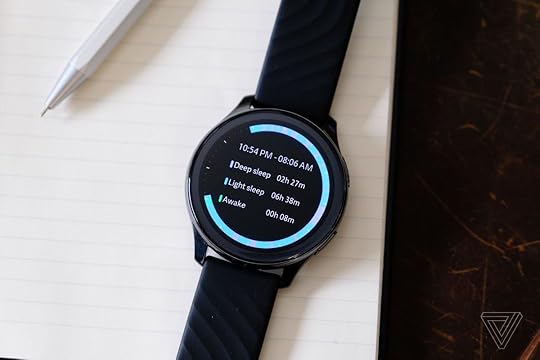 While the OnePlus Watch frequently undercounted my steps, it overestimated how much I slept each night.
While the OnePlus Watch frequently undercounted my steps, it overestimated how much I slept each night.Sleep tracking, oddly enough, has the opposite problem. The OnePlus Watch consistently overestimates how long I slept each night compared to the Fitbit and Google’s Nest Hub. A bug has also prevented the Watch from syncing its sleep data with the OnePlus Health app, even though other activity synced over fine. The company says this bug should also be fixed sometime this month.
As mentioned earlier, you can’t use other fitness apps on the OnePlus Watch. The OnePlus Health app provides syncing with the Google Fit platform, so it’s possible you could cobble together a syncing solution between other apps using Fit as glue, but I did not test this. In general, the OnePlus Watch’s fitness tracking is fine for basic activity trends, but any fitness enthusiasts will want something more capable and reliable.
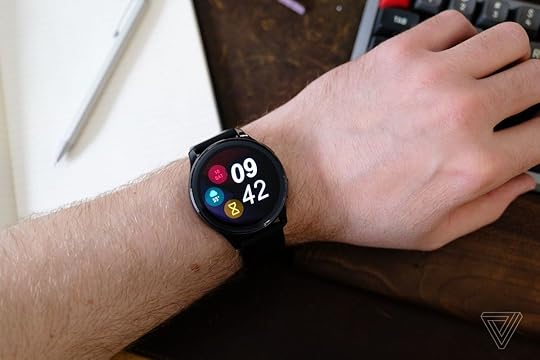 The OnePlus Watch only comes in one size: a large 46mm face.OnePlus Watch hardware and design
The OnePlus Watch only comes in one size: a large 46mm face.OnePlus Watch hardware and designIn terms of design, the OnePlus Watch is generic-looking — it reminds me a lot of Samsung’s Galaxy Watch Active line. It’s got a round face, there are two buttons on the side, and the body is made of polished stainless steel, which is nice to see at this price point. It comes in silver, black, or a gold-colored special edition — I’ve got the black model and it’s a little boring to look at. Either way, the hardware is solid and put together well — it’s not creaky or plasticky, and there are no rough edges to worry about.
Every smart device now requires you to agree to a series of terms and conditions before you can use it — contracts that no one actually reads. It’s impossible for us to read and analyze every single one of these agreements. But we started counting exactly how many times you have to hit “agree” to use devices when we review them since these are agreements most people don’t read and definitely can’t negotiate.
To use the OnePlus Watch, you must have an Android smartphone and the OnePlus Health app, which can be downloaded from the Google Play Store. Access to the Play Store requires a Google account and other agreements that are not directly related to the OnePlus Watch.
The OnePlus Health app has two things to agree to: the OnePlus Health User Agreement and the OnePlus Health Privacy Policy. You can read both agreements within the app before agreeing to them. In addition, you must have or create a OnePlus account to log in to the OnePlus Health app, which requires agreement of the larger OnePlus privacy policy.
Final tally: an Android smartphone with a Google account and three OnePlus agreements.
OnePlus is only offering the watch in one size, 46mm, and frankly, it’s big. It’s bigger than I like watches to be on my wrist, and if you have smaller wrists than me you’re not going to have a fun time with this. On the plus side, it’s not the thickest smartwatch I’ve ever worn. Just one size band comes in the box — OnePlus says that customers who need a shorter band will be able to get one by contacting customer service.
The touchscreen is a 1.39-inch 454 x 454 OLED that’s easy to see both indoors and out. It’s colorful, like you’d expect an OLED to be, but there’s no always-on display option, which nearly every other smartwatch has now. That makes it that much more annoying to check the time, though the wrist turn gesture does work well to wake it up.
On the underside are the sensors for heart rate and blood oxygen. As usual, you should not use these sensors for medical purposes — and blood oxygen monitors on even the best smartwatches notoriously struggle with giving accurate readings. Inside the watch are the accelerometers and gyroscopes necessary to track your activity and workouts, plus GPS and Bluetooth radios. There’s no Wi-Fi or LTE here — if you leave your phone behind, you’re going to miss notifications and alerts until the watch is back in Bluetooth range of your phone.
Also missing from the OnePlus Watch are any rotating bezels or crowns — the only way to interact with it is to tap and swipe on the screen itself or push the buttons on the side.
Even though it doesn’t have a voice assistant, the OnePlus Watch does have a microphone and speaker, so you can answer calls from your wrist via Bluetooth. It worked fine in my tests; callers said I sounded clear to them, but the speaker on the watch is a bit crackly at full volume. It works in a pinch.
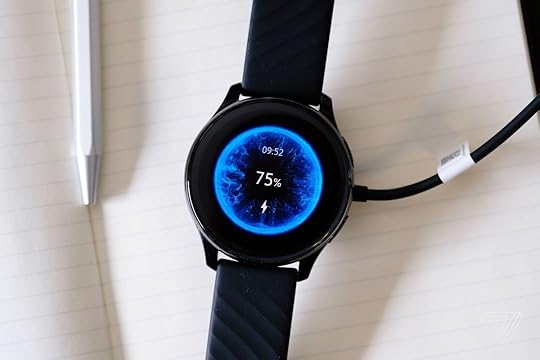 The OnePlus Watch has exceptional battery life and charges very quickly on its included charger.
The OnePlus Watch has exceptional battery life and charges very quickly on its included charger.The best thing about the OnePlus Watch is its battery life. OnePlus claims up to 14 days of usage between charges — it lasted about 10 days for me, wearing it day and night. Charging the watch is also quick and easy: just 20 minutes on the charger adds half a charge, which translates to literal days of usage. No Apple, Samsung, or Wear OS watch can last this long or charge this quickly.
But at the same time, the OnePlus Watch has such great battery life because, frankly, it just does less than those other smartwatches. The best comparison I can make is that the OnePlus Watch is a fitness tracker in a smartwatch body, which would be an acceptable premise if it were a better fitness tracker.
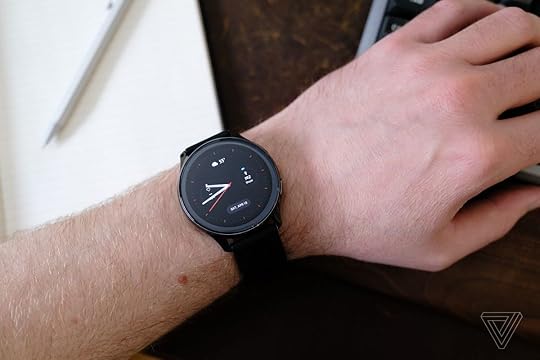 There are about 50 different watchfaces to choose from for the OnePlus Watch.
There are about 50 different watchfaces to choose from for the OnePlus Watch.The OnePlus Watch may look like a lot of other smartwatches, but I can’t say it compares well to them. It’s limited in features, only comes in one size, and as I’ve gone over, there are several bugs with it that make it feel like an unfinished product. Aside from its long battery life, the OnePlus Watch’s bestselling point is its low price, which is half that of a Samsung Galaxy Watch 3 and over $100 less than the comparably sized Galaxy Watch Active 2. But if you’re looking for a smartwatch for your Android phone, it’s not that hard to find Wear OS models on sale, often for less than the cost of the OnePlus Watch.
For me, a good smartwatch is a lot like a personal assistant on my wrist. It tells me the time, when my next calendar appointment is, what the weather is like, and how active I’ve been throughout the day. I can quickly ask it to set a timer when I’m making a cup of tea or use it to reply to a message from my spouse when I’m running an errand. It also lets me customize its appearance and capabilities through third-party apps, watchfaces, or both. For others, it’s a way to track workouts and keep on top of their personal health.
In that framing, the OnePlus Watch isn’t really a smartwatch and based on my experience, it isn’t a great fitness tracker either. Instead, it’s just a clever watch, and it can be useful if your expectations of it are low. But if a smartwatch is going to take up real estate on my wrist, it has to be more useful than the OnePlus Watch.
Photography by Dan Seifert / The Verge
The post OnePlus Watch review: big, basic, and boring, appeared first on NEWDAWN Blog.



